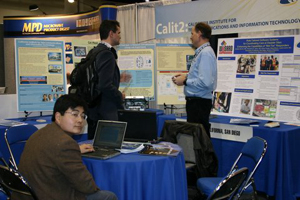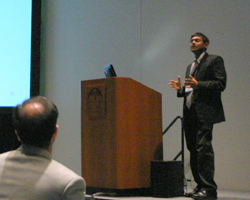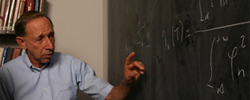UCSD, Calit2 Researchers Develop Better Power Amplifiers, RF Circuits for Wireless
January 25, 2006 / By Doug Ramsey
San Diego, CA, January 25, 2006 -- More efficient power amplifiers for wireless base stations. The coming fight between next-generation versions of Wi-Fi and 3G cellular. Micro-electro-mechanical systems (MEMS) for cell phones to switch among many different wireless standards worldwide. Those are just a few of the topics outlined by five UCSD engineering faculty affiliated with the Center for Wireless Communications (CWC), more than a dozen graduate students, and three senior researchers from the California Institute for Telecommunications and Information Technology (Calit2) during a week-long conference at the San Diego Convention Center, January 15-20.
|
MTT Wireless 2006 brought together international researchers who traditionally attended three separate meetings. The IEEE Radio and Wireless Symposium focused on communications systems and radio frequency (RF) implementations. The 6th Topical Meeting on Silicon Monolithic Integrated Circuits in RF Systems (SiRF06) dealt with silicon RF technologies and applications. The IEEE Topical Workshop on Power Amplifiers for Wireless Communications attracted leading RF power-amplifier engineers from industry and academe.
PA Workshop
The power amplifier (PA) workshop is usually held once a year at UCSD, but this year it was staged at the convention center, where it attracted more than 200 top players in power-amplifier research. "The PA Workshop was a big success this year and attendance more than doubled," said CWC director Larry Larson, the workshop's general chair. "At least part of that improvement was thanks to the co-location with the other conferences which also touched on subjects relevant to power amplifiers."
Apart from Larson, organizers included fellow Electrical and Computer Engineering (ECE) professor Peter Asbeck, who chaired the technical program, and Calit2 staff researcher Don Kimball. CWC and Calit2 also shared a booth in the MTT Wireless vendor exhibition, where UCSD researchers were able to meet one-on-one with attendees from all of the meetings. ECE graduate students were on hand to explain four of the 18 research posters on display during a poster session.
Larson points to two major trends at this year's PA Workshop. "One was the increasing use of digital signal processing in power amplifier design," he said. "DSP techniques can be used to improve the efficiency and linearity of power amplifiers, enabling a 'software defined' power amplifier for future systems."
"An even bigger trend was the emergence of a new semiconductor material technology -- gallium nitride [GaN] -- as a viable alternative to silicon for base station power amplifiers," added Larson. "This technology has been in the lab for many years, but is finally gaining commercial acceptance and has the potential to revolutionize base station design for 3G and 4G systems. UCSD has been collaborating with many GaN research groups to bring this technology to fruition, and we had several presentations at the workshop on this."
During a session focusing on base station applications, Calit2's Kimball presented a joint paper on the use of GaN-based Class E amplifiers - a form of 'switching' amplifier designed for a particular power output - "that offer significant advantages for high efficiency operation, although they have been largely limited to relatively low microwave frequencies or low-output powers." The team applied the amplifier to signals with time-varying envelopes such as those used in base stations, using a complex architecture known as 'envelope elimination and restoration/envelope tracking' (EER/ET).
|
They tested the system using a WCDMA single-carrier input signal, and achieved a power added efficiency (PAE) in excess of 48 percent at an average power level of 1.4 watts and peak power of more than 8 watts. "This work demonstrates that outstanding performance can be obtained from GaN heterostructure field effect transistors in conjunction with EER/ET architectures for base station applications," reported Kimball. "It also shows that Class E power amplifiers are attractive for very high power systems, even with time-varying envelope signals."
A higher power WCDMA Class E PA at 17W average power and 100W peak power at 44% drain efficiency was also reported in the same presentation. The RF PA from Cree measured only 2"x2"x1/4" and weighed 3.6 oz. This RF PA with ET/EER had the highest reported combination of power density and efficiency of any WCDMA base station amplifier. In fact, the PA was more than 10 times smaller than existing commercial PAs. Combining the Cree Class E high power PA with Calit2's ET/EER Amplifier shows that tower top Pico Size Basestations are feasible and cost effective for WCDMA long term evolution, and WiMAX Greenfield deployments.
|
Co-authors on Kimball's paper included Asbeck, ECE graduate students Chin Hsia and Jinho Jeong, and researchers from QUALCOMM, Nokia and North Carolina-based Cree Inc.
Last October, a team led by Kimball in Calit2's High-Power Amplifier Laboratory achieved greater than 50 percent PAE -- believed to be the best efficiency reported for a single stage base station power amplifier. At that efficiency, 60 watts of output power would require only 120 watts of DC power, rather than the 600 watts required by today's high-power base stations (which typically operate at only 10 percent efficiency).
UCSD researchers also co-authored two other papers presented during a PA Workshop session on technology for mobile stations and handsets. Peter Asbeck and Don Kimball worked with colleagues from UCSD, Nokia and Peregrine Semiconductor on "Real-time Adaptation to Antenna Impedance Mismatch for CDMA Transceivers." Separately, researchers from UCSD, Skyworks Solutions and Kopin Corp. demonstrated a power amplifier based on indium-gallium-arsenide-nitride (InGaAsN) technology.
Radio and Wireless Symposium
|
The largest conference under the MTT Wireless banner was the IEEE Radio and Wireless Symposium (RWS), and it included two major UCSD talks on power amplifier-related technology. One focused on silicon germanium (SiGe) Class E amplifiers. "SiGe technology is a strong contender for integrating the power amplifier with other transmit and receive microcircuits, especially for cellular handsets and wide local area network products," said Jeremy Popp, an ECE Ph.D. candidate who also works for the Space and Naval Warfare (SPAWAR) Systems Command-San Diego. His presentation was based on a paper about "A Fully-Integrated Highly-Efficient RF Class E SiGe Power Amplifier with an Envelope-Tracking Technique for EDGE Applications," co-authored by Calit2's Kimball, CWC director Larson, as well as guest lecturer and Dynamics Research Corp. researcher Donald Lie, and graduate student Feipeng Wang..
EDGE stands for Enhanced Data for GSM Evolution, the technology that extends the world's most widely used second-generation wireless standard, GSM. For researchers developing power amplifiers, the EDGE environment has pluses and minuses. The EDGE signal provides 3 bits of information for every symbol (i.e., better spectral efficiency) for a maximum bit throughput of 810kB/s. The disadvantage of the EDGE signal is that it has a moderate peak-to-average power ratio of 3.3dB. Using the envelope-tracking technique, reported Popp, the RF Class E power amplifier achieved an overall power added efficiency of 44.4 percent at an output power of 20.4dBm for an 881MHz EDGE modulated signal.
A second paper at RWS on power amplifiers focused on "Nonideal Effects of Reconstruction Filter and I/Q Imbalance Digital Predistortion." Digital predistortion is an approach to amplifier linearization that dramatically increases the efficiency of a multi-carrier amplifier by numerically generating a non-linearity that has a complimentary characteristic to that exhibited by the amplifier. The research was done by ECE graduate students Ming Li and Junxiong Deng (who is now at QUALCOMM), with their faculty advisors Larry Larson and Peter Asbeck. "They have done a lot of work on SiGe power amplifiers for WCDMA handsets, where the goal is to try to get the best possible efficiency over the broadest power range possible - while still meeting gain and linearity specifications that are standard for that system," said Larson.
The Radio and Wireless Symposium also featured a plenary talk about broadband wireless by QUALCOMM co-founder and Jacobs School professor emeritus Andrew Viterbi. The same day, Calit2 staff researcher Zhongren Arnold Cao delivered a paper on designing wireless devices with multiple antennas. His co-authors on "System Level Design Methodology for Wireless MIMO Prototyping" included Calit2/Ericsson scientist Magnus Almgren and ECE professor Bhaskar Rao, as well as ECE graduate students Nandan Das and Konstantinos Liolis.
SiRF06
Jacobs School electrical and computer engineering professor Gabriel Rebeiz delivered one of the invited talks at the 6th Topical Meeting on Silicon Monolithic Integrated Circuits in RF Systems (SiRF06). With the continuing proliferation of wireless standards (or 'bands') that vary by region or even by country (WCDMA, GSM, etc.), cell-phone makers are trying to build phones that work across all standards. That requires shrinking the size of the components down to the MEMS sub-millimeter scale. In his talk on "RF MEMS for Wireless-Bands Tunable Networks," Rebeiz explored the huge potential of the tiny devices not only to pack functions into less space, but also to use less power - thereby extending the life of cell-phone batteries.
During the SiRF06 poster session, graduate students from CWC explained their research in two of the 36 projects showcased, and another student, Yiping Han, took third place in the workshop's student-paper competition (for "A Low-Voltage 12GHz VCO in 0.13 ?m CMOS for OFDM Applications"). Han presented his paper (co-authored by CWC director Larson and Donald Lie) on Friday during a SiRF06 session on RF circuit blocks. In the same session, graduate student Rahul Kodkani presented on "A 25 GHz Quadrature Voltage Controlled Ring Oscillator in 0.12?m SiGe HBT," co-authored by Larson.
Related Links
MTT Wireless
Power Amplifier Workshop
IEEE Radio and Wireless Symposium
SiRF06
UCSD Electrical and Computer Engineering Department
Center for Wireless Communications
Calit2
UCSD Researchers Report World Record Efficiency for High-Power Amplifiers for Cellular Base Stations
Media Contacts
Media Contact: Doug Ramsey, (858) 822-5825, dramsey@ucsd.edu





